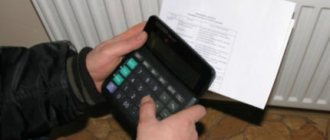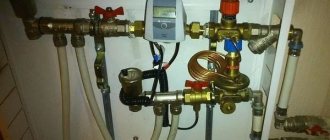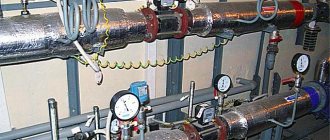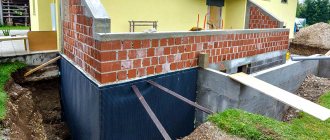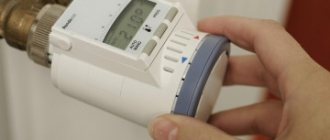SHARE ON SOCIAL NETWORKS
FacebookTwitterOkGoogle+PinterestVk
Heating in the cold season is an important component of a comfortable life, but every year heating services become more and more expensive. The radiator temperature is not always sufficient for normal heating. By installing a heating meter in your apartment, you will need to pay not for the standards established by utility services, but only for actual consumption. Already during the first heating season it will be possible to reduce the expenditure of the family budget.
Thanks to the meter, you only need to pay for actual heat consumption
Why is it necessary to install a heating meter in a residential area?
The lack of high-quality heating due to improper operation of the heating network often forces apartment residents to look for alternative heat sources. At the same time, the cause of poor heating is not always a breakdown in the heating network. Often, housing and communal services workers, in an effort to save money, tighten the valve, which reduces the flow of hot water, which is especially felt by residents of the upper floors of high-rise buildings.
Quite often, due to poor performance of the heating network, it is necessary to look for alternative heat sources
This results in insufficiently warm batteries and the need to use electric heating devices, which, in turn, entails increased energy costs. Heating in an apartment does not become cheaper. The result is that users have to overpay on all fronts.
Important! An installed and registered heat meter for the battery will allow you to pay only for the heat consumed by a particular apartment, and for nothing more.
Another reason for high payments is often the difference in the temperature of the water that comes out of the boiler room and the one that goes directly into the apartment. Often, the temperature of the water in the radiator is significantly lower than normal, which occurs due to heat loss on the main line due to poor insulation or damaged pipes. Even in this situation, all costs fall on the shoulders of the end consumer.
Sometimes the situation can be completely different when the radiators are so hot that you have to open the windows to ventilate the room. In this case, you have to pay, in fact, for heating the street, which is also not considered correct. Regulators, which are often installed together with heat meters for heating, will help you avoid problems.
Scheme of operation of a heating meter in an apartment
The main advantages of installing a heat meter in an apartment
The heat energy meter is mounted directly on the pipe through which heating enters the apartment, and calculates only the amount of heat actually used. If you additionally install a thermostat to the device that controls the flow of water, you will be able to control the flow of hot water, which can be reduced if necessary. As a result of the work done, the final consumption figure will be significantly lower than that determined by the standards.
After installing and registering a heat meter in an apartment, you can be sure that only the costs of heating the home will be taken into account in the payment. You will not have to pay for heat losses during transportation or associated costs resulting from poor-quality services provided by the heat generating company after installation. Heat metering is carried out based on the following indicators:
- consumption of hot water delivered to the apartment;
- water temperature at the entrance to the heating system and at the exit from the apartment.
As a result of expenses, the amount of heat consumption per day, month or year, calculated in hectacalories, is determined. Modern apartment heat meters have the ability to store data on monthly heat consumption for a long period, usually up to 10 years. Some devices have an additional option that allows you to connect it to a computer and transmit readings via the Internet.
The main advantage of the meter is the ability to significantly save money
If there is any doubt whether a heating meter in an apartment is profitable, you can pay attention to a simple calculation: the price of the device together with installation is from 7 thousand rubles, and the minimum service life is 12 years. Over the course of one season, you can save from 4 thousand rubles on heating using a meter, which depends on the area of the apartment. Accordingly, over 12 years of use, at least 48 thousand rubles are saved, and this figure is far from final.
Helpful information! The only option when you should think about whether it is necessary and possible to install a heating meter in an apartment is if the housing has a vertical connection system and has not one riser, but several. In this situation, each riser needs its own meter, and this is already expensive. In such a situation, it is recommended to install one device per entrance.
The costs of operating the meter are insignificant, because basically you only pay for calling a specialist to check the device, which is carried out no more than once every 5 years. It is also sometimes necessary to replace the batteries, but this also has to be done by those who do not use the meter.
Required documents
It is also worth remembering that installing such a device entails many difficulties, and, in addition to collecting a certain list of documents, unexpected expenses may arise. It will take several weeks to prepare the documentation yourself; you will have to visit the relevant institutions and collect the following:
- design data of the heat consumption device;
- technical conditions set by the authority providing the building with heat;
- permission from the balance holder of the building.
Additional coordination of all calculated data with the established values is required. The installation is carried out in accordance with all project information, after which an agreement is concluded with the energy supplier on the main documents for payment based on data from the apartment meter. Next, a representative of the relevant authority draws up a certificate of delivery of the installation and registers the device.
As it may seem at first glance, this does not cause any particular difficulties, but each of the points may imply an additional list of documentation, and receiving each of them may take up to two weeks.
Main types of heating system wiring in a residential building
Multi-storey buildings can have one of the heating system layout options - vertical or horizontal. Old buildings, such as Khrushchev and Stalin buildings, are mainly characterized by a vertical heating system. In this case, the heating network circuit can be one- or two-pipe. However, the flow of coolants through interfloor levels has a sequence from bottom to top and top to bottom. The main disadvantages of vertical wiring:
The heating distribution system in a multi-storey building can be vertical or horizontal
- The heat is distributed unevenly, because the coolant is driven along the interfloor circuit with a vertical orientation. As a result, apartments on different floors will receive unequal amounts of heat. Thus, apartments in a 10-story building up to the 5th floor will be heated better than the last 5 floors.
- The complex process of regulating the flow of heating into the radiators and the need to install on each battery an additional jumper in the form of a pipe, the so-called bypass, which regulates the flow of coolant in the radiator.
- Constant reconfiguration of shut-off valves depending on changes in pressure and temperature of the water supplied to the system.
The main disadvantage of vertical wiring is the difficulty of installing an individual heating meter in an apartment, because you will need to purchase a separate heat meter for each riser, which significantly increases costs. In this case, another tool for measuring energy consumption is more often used - a heat distributor, the installation of which will require the consent of at least 50% of the residents of the entrance.
Most new buildings are distinguished by horizontal heating distribution, when there is also a vertical riser designed to distribute the coolant to different floors, and a return line. From both the first and second risers, horizontal pipes are installed into each apartment, carrying out both the supply and return outflow of water from the system. The return line serves to collect cooled water and transport it back to the heating station. The advantages of horizontal wiring include:
- the ability to regulate the temperature of the heat supply to the radiators of each apartment;
- carrying out system repair work in a separate circuit without disconnecting other apartments;
- the ability to disconnect each circuit separately from the heating.
Diagram of a horizontal heating system in an apartment building
Peculiarities
Prices for individual metering devices on average start at 4,000 rubles. Ultraviolet, more modern mechanisms will cost more, but their installation is not always rational in communal conditions.
A vertical heating circuit is characterized by the connection of several sections to one riser. In this case, one riser pipe goes down, and the other comes out from above. Pipes in a horizontal pattern come out from the bottom and return back. This type of wiring has become most widespread in modern homes, although its arrangement is more expensive than the vertical version. Both types of breeding, one way or another, relate to water supply.
Options for heating meters: individual and communal devices
Depending on the conditions and layout of the heating network, there are two types of heat meters: a communal one and an individual one for each apartment. Both methods have the right to life, and each has its own advantages and disadvantages.
A common house heat meter in an apartment building is considered an excellent option, especially if the majority of residents are willing to financially participate in its installation. Despite the fact that the cost of installation and the price of the heat meter are quite high, if the final amount is distributed among the residents, the result will not be such a large figure. Accordingly, the more people want it, the cheaper the work will cost. Every month, data from the meter is taken by employees of the heat supply organization, who distribute the resulting figure between apartments, taking into account the area of each.
Important! If the service provider does not comply with the contracted temperature of the water supplied to the home heating system, then by law he will be obliged to return the money spent to users.
Before purchasing a general heat meter for heating, you should solve the following problems:
Heat meters can be individual or communal
- Hold a meeting of residents of the house, interview those who are willing to invest personal funds in installing the device. Installing the device is allowed only when the majority of people living in the house are ready to support the idea.
- Discuss the features of subsequent installation, select a supplier company that will take readings from the meter and issue receipts for thermal energy consumption for each consumer.
- Be sure to record the results of the meeting in the minutes and send a written statement of your desire to install a heating device to the company that is responsible for heat supplies.
- Draw up an agreement with the heat supply organization and pay for the heat energy used upon delivery.
To avoid delaying the meter installation process, experts recommend immediately contacting companies that provide the full range of installation, project creation and approval services. You also need to find out in advance whether the current heating service provider is installing meters. Often, utility services have agreements with private companies that install heat meters in the houses entrusted to them on preferential terms.
As for the benefits, installing heating meters in the house is considered an economical solution. However, there are some nuances. For example, if the windows in the entrance are old and broken, then the heat loss through the entrance will be significant, which will subsequently affect the final amount for heating. Sometimes, due to such losses, heat costs can exceed standard standards. These nuances must be foreseen in advance and the feasibility of installation must be assessed.
To install a communal meter, the consent of at least half of the residents is required
Individual heating meter for the apartment
Despite the fact that in some cases, installing heat meters on a house or entrance will cost less, the economic effect may not be expected in the near future. For this reason, many consumers prefer individual meters, which are installed directly in each apartment.
Helpful advice! The price of individual heat meters in an apartment is higher, but as a result of installing the device, the payment for heat will be lower than when using a common house device.
Before installing a metering device, you first need to understand how the heating meter works in an apartment. So, the operation of an individual device involves placing a distributor on each battery, the task of which is to record the temperature and its fluctuations over a certain period. Typically, differences over the course of a month are taken into account. Based on the obtained indicators, payment for consumed thermal energy is calculated.
To understand whether it is possible to install a heating meter in an apartment, you need to know some restrictions that arise for technical reasons. Considering that the heat meter is installed on each riser, then if there are several risers in the apartment, the installation of several devices will be required. Therefore, when installing vertical heating, distributors are installed that calculate heat consumption based on the temperature difference on the surface of the radiator and in the air of the room.
Installing an individual meter will cost more than a common house meter, but the cost savings due to it are also significant
With horizontal wiring, installing the meter on a heating radiator is much easier. In rare cases, heating devices are attached to the return line, but in this case the calculation takes place according to a different principle.
Saving
If the apartment has high-quality thermal insulation and a constant temperature around 25 degrees Celsius, using the regulator, you can change the heating mode to a more comfortable one, while significantly fewer gigacalories will be spent. Shut-off valves are used to regulate and control the supply of thermal energy to radiators. A noticeable difference in bills occurs even with one turn of the tap.
Apartment heat meters for the battery are installed mainly on a horizontal heating circuit, which has a separate floor section. The location of the living space is of particular importance. People living in corner apartments on the top and first floors, subject to a comfortable temperature range of 15 to 22 degrees Celsius, will not notice much budget savings.
What you need to consider before installing a heating meter in your apartment
The placement of heat meters in houses in the Russian Federation is regulated by Federal Law No. 261, which obliges the installation of common household devices that take into account heat costs. Installation is carried out at the expense of associations of apartment owners, the so-called condominium associations. The payment method and methodology for calculating services in houses with an installed heat meter are regulated by Resolution of the Cabinet of Ministers of the Russian Federation No. 354. The main points of this resolution include the following:
- If there is no thermal energy calculation device at the entrance to an apartment building, payment for heat supply is calculated using an increased coefficient, which in 2022 was equal to 1.5.
- According to the laws of the Russian Federation, the owner of the apartment is not obliged to install a heat meter in the apartment, but there are also no laws prohibiting the performance of such work.
- Heat meter readings for heating in an apartment will be taken into account only in a building where not only 100% of the apartments, but also heated common areas are equipped with heat meters. The installation of a common metering unit in the house is also considered a prerequisite.
- A personal-use device is commissioned by a heat supplier and serviced by its employees. Repair, verification or replacement of the heat meter is carried out at the expense of the apartment owner.
An individual heat meter is serviced by the supplier company at the expense of the owner
From the above theses it follows that the installation of a common heating unit in a house is considered mandatory, because otherwise heating services may increase by 1.5 times, and the data from the personal meter will not be taken into account at all. For these reasons, there is no point in installing heating meters in an apartment if there are rooms in the house with uncontrolled heat consumption.
Important! According to the law, a utility provider may allow the installation of a device, but when drawing up a payment, it has the right not to take into account the obtained indicators. Therefore, these kinds of nuances need to be decided in advance - before installing the meter, so as not to end up with senseless waste.
In some cases, if there is no technical capacity to install a common house unit that controls the flow of heat into the house, an official certificate is issued confirming the impossibility of carrying out the work. Therefore, the only correct option is to install a heat meter in the apartment and separately in the entrance, because an individual device does not take into account the consumption of thermal energy spent on heating non-residential premises, which includes:
- staircases and landings;
- Technical buildings;
- basements;
- storage rooms.
Related article:
Screen for a heating radiator: a protective and decorative element in the room
What is he like? Element functions. Types of gratings depending on the design, mounting option and material of manufacture.
Is it possible not to pay for installing a meter?
In some cases, a heat meter can be installed free of charge. This option is possible when residents do not have the funds to pay for a heat meter.
The management company or homeowners association enters into an energy service contract. According to it, the energy service company purchases and installs equipment at its own expense.
After installing the structure and putting it into operation, the heat meter is leased. Payment for equipment is made at the rate of 80% of the savings achieved. The energy service company takes it, and 20% remains the property of the residents.
For example, a house paid 400 thousand rubles for heat before installing a meter. After installation, the payment decreased to 350 thousand. Saving 50 thousand rubles. The energy supply company takes 40 thousand rubles.
According to the leasing agreement, she receives 300 thousand. Thus, after (300/40=7.5) 7.5 months, the equipment will be transferred to the residents of the house. After the heat meter is handed over to the residents, all savings are distributed among the apartment owners.
Read what the temperature in the apartment should be during the heating season and how to request a recalculation for cold radiators.
Main types of heating meters for an apartment or house
The main task of heating meters in an apartment, multi-storey or private house is to calculate the amount of energy consumed to warm up a particular home. This takes into account not only the volume of water that passed through the radiator, but also the energy consumption given off by the water in the room. The formula for calculating the amount of heat is as follows:
Any of the selected meters must have a certificate and passport
Q=V*(T1-T2), where:
V – volume of water passing through the heating system; T1 – water temperature in the supply riser; T2 – temperature indicators of water in the outlet main; Q is the amount of heat received by an apartment or other premises, on the basis of which the amount in the payment is calculated.
Based on the data required for the calculation, the heat meter for the battery must have a rather complex design. Regardless of the type of device, it consists of the following elements:
- Flow sensor. Installed on the supply riser of the heating system to calculate the used volume of water passing through the system in a set unit of time.
- Thermal converters. These are temperature sensors installed in the device in the amount of two pieces (separately on the inlet and outlet pipes). The converter measures the difference between incoming and outgoing water and calculates the amount of heat spent on heating.
- Calculator. This is the element responsible for calculating the received data and converting it into the amount of heat consumed. Depending on the model of the device, there is either a push-button or touch control panel, with the help of which data is entered.
Ultrasonic, vortex, tachometer and electromagnetic meters are used for apartments
Important! Whatever device is chosen for installation in an apartment or in a house, the device must have a passport and certificate. It is necessary that the documents contain information about the initial verification of the meter carried out by the manufacturer. All information must be duplicated on the body of the heat meter in the form of a sticker or stamp. Most devices come with a verification sheet, which is filled out by the responsible person.
A large number of battery meters are allocated, but in apartment conditions the following types are mainly used:
- mechanical (or tachometer);
- electromagnetic;
- vortex;
- ultrasonic;
- overhead sensor.
Main characteristics and prices of meters for heating batteries in an apartment
Mechanical heat meters in apartments got their name due to the fact that coolant flow rates are calculated using an impeller immersed in a pipe. The operation of the device is carried out using two sensors embedded in the supply and return lines. The task of the sensors is to calculate the consumption of thermal energy by determining the difference in water temperatures. The main advantage is the low price of the heating meter (from 5,200 rubles). Many experts note the excessive sensitivity of the device to the quality of the coolant, as well as the poor protection of the device from penetration inside in order to twist the indicators.
The cost of a heating meter for an apartment starts from 22 thousand rubles
The principle of operation of an electromagnetic meter for a heating battery in an apartment is to calculate the electric current generated when coolants pass through a magnetic field. The devices are characterized by stable operation and are widely used. If during the installation process the wire connections were made poorly or any impurities got into the coolant, inaccurate transmission of measurements is possible, which can lead to both savings and unnecessary costs. The advantages of electromagnetic meters include:
- high accuracy of the data obtained;
- long service life;
- Possibility of installation in any convenient position.
Among the disadvantages, it is worth noting the price of a heat meter, which starts from 22 thousand rubles, which significantly exceeds the cost of other types of devices. Also, when installing the device, you should be especially careful when connecting the electrodes to avoid inaccuracies. Due to the high cost of not only the device itself, but also its maintenance, it is rarely used.
What are vortex heat meters in an apartment: prices
The design of a vortex heat meter for an apartment is created taking into account the fact that when coolant enters the device, special vortices are formed, resulting from an obstacle that is built into the device. By determining the frequency of each vortex that arises, which is proportional to the speed of fluid movement in the coolant, the energy consumption is calculated.
Vortex meters are characterized by a long service life
The speed is read using either ultrasound or a magnetic field, after which the volume of heated water in the heating system is determined. The vortex thermal metering device has the following advantages:
- affordable price of a heating meter for an apartment - from 10-12 thousand rubles;
- long period of work;
- minimal wear of parts, which significantly reduces the cost of repairing or replacing the device;
- possibility of installation not only with horizontal, but also with vertical wiring of the heating system;
- minimal energy consumption.
Interesting information! To measure the amount of heat consumed by an apartment building or industrial facility, a so-called industrial or house heat meter is installed, which can be vortex, turbine or electromagnetic. The main difference between household and industrial appliances is the size of the pipe cross-section. The price for the device starts from 23 thousand rubles.
Among the disadvantages of using a vortex device is the complexity of installation, which requires the use of a large span of pipeline. Other disadvantages of the device:
The price of a vortex meter for heat starts from 23 thousand rubles
- High sensitivity to extraneous vibrations, which can cause the device to fail over time.
- The device is demanding on the quality of the heat carrier, because when contaminated water is supplied, the indicators can be distorted.
Ultrasonic individual heating meters: prices
Ultrasonic meters for heat in an apartment calculate the coolant flow thanks to an ultrasonic signal, which is supplied by the emitter and read by the receiver. Both elements of the device are mounted at a certain distance from each other on a horizontal heating radiator. The notification emanating from the emitter moves with the coolant flow and reaches the receiver after a certain period of time, which depends on the speed of movement of warm water in the heat supply system circuit. Thermal energy consumption is calculated based on the time it takes for the signal to travel from point to point.
Over 10 types of ultrasonic heat meters for apartments are produced, but the most popular include:
- frequency;
- Doppler;
- correlational.
In addition to the main task of calculating energy costs, the flow meter may have an additional built-in function that regulates the flow of hot water into the system. The main advantages of using an ultrasonic device:
A foreign-made ultrasonic meter costs from 12 thousand rubles
- Low cost of the device with standard equipment. The price of a heating meter for a domestically produced apartment starts from 8 thousand rubles, and a foreign one – from 12 thousand rubles.
- User-friendly interface. Cost figures are displayed on the LCD display at the touch of a button.
- After installing the device, there is no change in the hydraulic pressure of the heating system.
- Long service life - at least 10 years. In this case, verification should be carried out no more often than once every 4 years.
- Powered by a battery built into the device, which eliminates operation failure as a result of power surges or power outages.
Like most other devices, according to reviews, an ultrasonic heating meter for an apartment is also sensitive to the quality of water in the heating system and may fail briefly due to the appearance of air bubbles or dirt particles formed as a result of scale or scale. Most often, the indicators change upward. The main condition when installing an ultrasonic heat meter is the presence of straight pipe sections in front of and after the device. The total length of the straight pipe section should not be less than a meter. Only in this case do manufacturers guarantee the accuracy of the calculated readings.
The best heat meters according to consumer reviews
We bring to your attention the most popular models of heat meters:
- Elf DN 20 mm. Tachometer heat meter made in Poland. Designed for low thermal power (up to 85 kW). Capable of remotely reading readings from automation. Absolutely resistant to magnetic influences, has wide communication capabilities.
- Sensonic II DN20. A reliable compact device with high accuracy in measuring indicators of the consumed type, having an acceptable cost.
- SensoStar 2 Engelmann. The German-made model, represented by a design of exceptionally high-quality assembly, very accurately determines the amount of heat consumed by magnetic-free scanning of the impeller.
- KARAT-Compact-201. Easy to maintain, compact, low cost and modern design. The unique technology for creating device parts makes them wear-resistant and corrosion-resistant.
As you can see, choosing the optimal heat meter model is a fairly simple process. The main thing in this matter is a clear understanding of your needs, the desire and ability to spend a certain amount of money and follow the advice presented above. Happy shopping!
Thermal energy calculators and distributors: advantages of use
Heat calculators and allocators are meters that calculate the relative costs of heat energy. They consist of a thermal adapter and two elements characterized by sensitivity to temperature changes. Sensors measure the temperature of the surface of the battery and the air in the room every 3 minutes, determining the difference in indicators. The resulting values for heat consumption are added up and generated on the device screen.
Devices of this type will have to be installed on all batteries in the apartment
Heat calculators on each sensor are set immediately before installing the device and putting it into operation. To do this, all the required coefficients and power indicators are entered into the memory of the thermal energy meter, which then allow the device to display the amount of heat consumed.
Important! The data displayed on the device screen are conventional units, to convert which to kW/h it is necessary to multiply the resulting figures by the power of the heating radiator, which is indicated in the product passport, as well as by the coefficient corresponding to the type of radiator, confirmed by the meter manufacturer.
Due to the fact that distributors and calculators determine the consumption of thermal energy in one radiator, their number must correspond to the number of batteries in the apartment. Both types of heat meters work properly, regardless of the quality of the coolants circulating in the heating system. Other advantages are:
- relatively low price of devices - approximately 2000-3000 rubles;
- long service life - more than 10 years;
- simple and easy installation on the battery surface;
- the presence of a single controller that calculates the sum of indicators read from several devices (the option is not available in all models).
Calculators and distributors can produce an error of up to 12%
Before installing a heating meter in an apartment of this type, you need to take into account that the relative error of the obtained indicators in some cases reaches 12%; heat distributors show a particularly large deviation. You also need to carefully approach the purchase of a kit for installing the device, which must match the type of battery installed. If you choose the wrong kit, the quality of information collection will be significantly reduced, so without a specialized installation kit, it is more advisable to simply install the heat meter near the radiator.
Assortment of heat meters in the Alfatep online store
After all the issues with obtaining permits have been “settled”, you can begin to select a device, and for this we invite you to our online store “Alfatep”, which presents heat meters from different manufacturers and differing operating principles. Therefore, choosing a device taking into account technical parameters is not difficult, especially if you use the help of our specialists. For this purpose, there is a feedback service on the online store website. We also propose to solve the issue of delivering goods to the site: this service is performed by our own logistics service.
At the same time as purchasing a heat meter, you need to take care of purchasing additional elements for installation work: thermostats for radiators, bypasses, filters and others - all these products are presented in our online store in a wide range.
Principle of operation
The heat meter always determines and uses two indicators:
- The amount of coolant passed through the pipes.
- Changes in the temperature of the coolant as it passes through all the radiators of the apartment. It is detected by two sensors.
By combining this data, it determines the total amount of heat entering the apartment. The deduction is made according to the formula: Q = c*m*(t1-t2), where
- c is the specific heat capacity of the coolant (since water often plays its role, this indicator is unchanged and equals 4.187 kJ/kg*C°),
- m represents the mass of water or other heated liquid,
- t1 and t2 are the temperature levels of the water passing through the supply and return pipes, respectively. The unit of temperature is C°.
How to convey testimony correctly
An apartment heat meter is functionally much simpler than a modern mobile phone, but users periodically have misunderstandings about the process of taking and sending display readings.
To prevent such situations, before starting the procedure for taking and transmitting readings, it is recommended to carefully study its passport, which provides answers to most questions related to the characteristics and maintenance of the device.
Depending on the design features of the device, data is collected in the following ways:
- From the liquid crystal display by visually capturing readings from various menu sections, which are switched by a button.
- ORTO transmitter, which is included in the basic package of European devices. The method allows you to display and print extended information about the operation of the device on a PC.
- The M-Bus module is included in the delivery of individual meters in order to connect the device to the centralized data collection network of heat supply organizations. Thus, a group of devices is combined into a low-current network using a twisted pair cable and connected to a hub, which periodically polls them. Afterwards, a report is generated and delivered to the heat supply organization, or displayed on a computer display.
- The radio module included in the delivery of some meters transmits data wirelessly over a distance of several hundred meters. When the receiver comes within range of the signal, the readings are recorded and delivered to the heat supply organization. Thus, the receiver is sometimes attached to a garbage truck, which, as it follows a route, collects data from nearby meters.
Archiving of readings
All electronic heat meters store in the archive data on accumulated indicators of thermal energy consumption, operating and idle time, coolant temperature in the forward and return pipelines, total operating time and error codes.
As standard, the device is configured for various archiving modes:
- hourly;
- daily;
- monthly;
- annual.
Some of the data, such as total operating time and error codes, can only be read using a PC and special software installed on it.
Transfer of readings via the Internet
One of the most convenient ways to transmit readings of consumed thermal energy to institutions for its accounting is transmission via the Internet. Its convenience and practicality lies in the ability to independently control payments and debts, as well as track heat consumption at different periods without standing in queues and spending a small amount of time.
To do this, you must have a personal computer connected to the network and the address of the website of the controlling organization, as well as the login and password of your personal account, after logging into which a form for entering readings will open. To prevent disagreements from arising in the event of a possible failure or malfunction on the site, it is advisable to take “screenshots” of the screen after entering information.
What does the user get from installing a heat meter?
The cost of heating increases every year. Some people try to solve this problem by taking a more economical approach to heat: installing new windows and insulating their home. Modern double-glazed windows are energy efficient and allow you to save about 30% of heat. Very often the owner of the house has to pay a lot of money during the heating season. At the same time, batteries do not always heat the room at the proper level. As a result, a person pays for what he does not receive. In this case, heating meters are an excellent option for saving money. By installing a meter in your apartment, you can save about 40% of the total payment for heating services. The installation of a measuring device pays for itself within 3 to 6 months of the heating season. Sometimes poor heating is associated with the negligence of service workers, with the reluctance of the operator to lose money on achieving the required coolant parameters. If the apartment has a heating meter, this can become a significant argument in the event of litigation with utility services.
